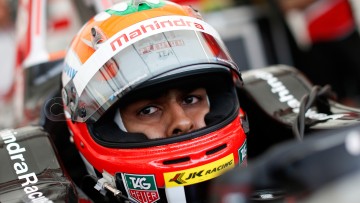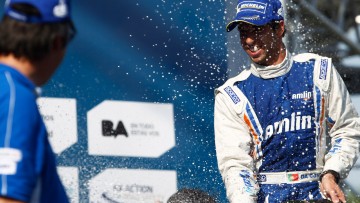Racing drivers love speed. So with this in mind, what is the appeal that has drawn top names from so many areas of motor racing to Formula E in its first season? It’s well known that the first iteration of the Spark-Renault SRT_01E is not the most powerful of beasts, but it is merely the first step on a journey that is set to encompass phenomenal improvement in terms of car and technology performance.
Formula E cars will almost certainly become fearsome to drive in the future – the championship’s chief executive Alejandro Agag is promising a “significant” increase in speed for the second season as the involvement of car manufacturers ramps up – but for now the formula takes vastly experienced drivers back to the earlier days of their career when they were finding their feet in low-powered racers. Yet there is something about Formula E that has not only drawn the interest of top international stars, but has kept them coming back for more throughout its first season.
The speed of the cars – they produce a maximum of 270 brake horsepower in qualifying mode and rarely surpass 200kph at the moment – is irrelevant to Jean-Eric Vergne, who has found a home in Formula E after spending three years in Formula 1 with Toro Rosso.
I’ve learnt a lot about energy-saving and driving efficiently, and that’s purely from driving in Formula E… Karun Chandhok
“It kind of works how it is at the moment – it’s still great racing,” Vergne says. “As a driver you always wish you could have more power, more grip, less weight, but you can have a lot of fun even in go-karts if you are with top drivers. We are on the ground floor of potential of Formula E. This is all just the beginning – and for the beginning, it’s very good.”
Karun Chandhok, with Formula 1 and Le Mans experience under his belt, agrees. “It’s not a high-speed driving challenge,” says the top Indian driver. “The speed isn’t great, we all know that, but because the level of driver is so high, we’re pushing really hard. That makes the quality of the racing really good, so it’s fun.”
Vergne adds: “You can still have an amazing race. Even if the car is not quick, it’s still extremely difficult to drive. You talk to the other drivers and we all say we struggle more to be quick in this than in an F1 car. That’s the challenge. It’s a lot more difficult to maximise everything. In F1 you know exactly what you can do in each corner and you trust it. Here you cannot be sure of anything – the car is always moving around, it’s not easy, but that’s exciting.”
Championship leader Nelson Piquet Jr, son of the three-times F1 world champion, has mastered the category better than most, particularly over the second half of the campaign, and he believes that blending the difficulty of driving the cars that Vergne speaks of with a measured approach behind the wheel is the key to getting the most out of them.
“You have to be confident with the car,” Piquet says, “but that is a big issue for some of the drivers this season and you need the team to find ways to make it work for you. If you build that confidence, then you have to take control, stay calm and not make mistakes. The most important thing is to do everything cleanly and try to be as efficient as possible in the car. You have to do your homework – areas like getting the brakes working well are really important.”
While the cars will get faster, Formula E has set itself up in a way that means it’s not crying out for more speed. The street circuits are designed with the car’s specifications in mind, so often they are shorter and twistier than conventional city tracks raced on in other championships.
“All drivers love street circuits,” says Chandhok. “These days so many things are so sanitised, you rarely get that buzz of driving where you’re living on the edge. You get that in Formula E – ‘whoah, am I going to hit the wall?’ – and it’s very special.”
As race winner and BMW touring car driver Antonio Felix da Costa points out, the lack of sound from the electric motor gives a different sensation of speed.
“It feels faster without the sound,” says the Portuguese driver, who won the Buenos Aires round. “And on these tight circuits you don’t need the top speed to be much higher.
“It would be nice to have more power when you first press the accelerator. At the moment you just hit it coming out of every corner and it’s fine – no wheelspin, no trouble. So it could be more challenging in that respect. But top speed is not so important.”
By racing cars featuring technology that has never been pushed to a high level in motorsport, the drivers are also learning a thing or two. Just this month, at the Le Mans 24 Hours, where nine Formula E drivers were in action, the benefits of the electric championship were being felt.
“Without really thinking about it, my natural style now means I was 5 per cent more [fuel] efficient at Le Mans than I was last year,” says Chandhok. “I’ve learnt a lot about energy-saving and driving efficiently, and that’s purely from driving in Formula E.
“If you look at racing across the world, they’re all going hybrid, so fuel management and engine management is becoming increasingly important.”
Perhaps the biggest compliment any driver can pay to the first iteration of Formula E car is to not single it out in the first place. Scotland’s Dario Franchitti, a legend of American IndyCar racing, sampled the car in Moscow and his verdict of “it just feels like a normal racing car” will have been music to the ears of those involved in the project.
So perhaps speed isn’t everything. There are certainly faster racing cars out there that are easier to drive, but as the current drivers in Formula E will attest, sometimes the challenge of a slower car outweighs the appeal of simple speed.


